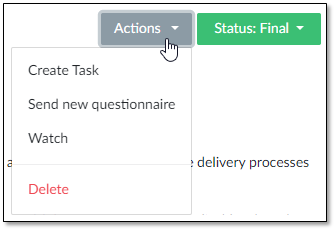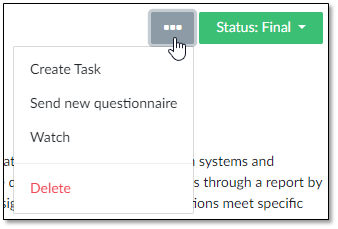- Created by Tristan Mohn , last modified on May 29, 2019
You are viewing an old version of this content. View the current version.
Compare with Current View Version History
« Previous Version 46 Next »
Page Contents
Overview
Once an item's details page is opened from a module's home page, there are additional fields to view and edit.
For example: If you need to view survey results for an item or change an audit's start date, you can do that by following the actions in this tutorial.
Accessing the Details Page
NOTE
The example below opens the details page from the Programs home page. For instructions on how to access a module's home page, please see /wiki/spaces/ZenGRCOnboardingGuide/pages/359071970.
To access details of an object from a module's home page, complete the following steps:
- Click a linked item in the Title column.

The details page displays with the default opening on the Details tab.

Clicking Through Items
On the To-do List and Audits modules, the details page opens in a new window on top of the existing page. This provides a way to keep your place in the application. In addition, forward and back arrows allow clicking to the next item without closing to reopen another item.
.
Modules other than the To-Do List and Audits open the details page with a link at the top to return to the object's home page as shown in the screenshot below.
Alternatively, use the browser's back button to return to the prior page.
Actions
The Actions dropdown displays on every object. However, depending on the resolution of your monitor and the width of your browser, the wording varies.
Maximum Width
When your browser is maximized, the button says Actions with various dropdown options, depending on the ZenGRC module displayed.

Minimum Width
When your browser is minimized or on low resolution, the Actions button displays as an ellipsis, instead. The dropdown selections are the same as the maximum width and depend on the ZenGRC module displayed.
Statuses
Each object has different status selections depending upon the actions required. The dropdown is found on the top, right corner. For additional information, see the documentation for each object.
Tab Overview
There are other tabs on the page that provide valuable information and functionality. Depending on the object type that is opened, there may be differences in the fields displayed.
Details
All objects display a Details page, which is named after the default tab displayed when an object's Title is clicked. This tab contains information such as notes, start dates, and any applicable URLs.
Mapped Objects
The Mapped Objects tab provides the same detail and editing capabilities as the home page. In addition, the view can be filtered, sorted, customized and exported in the same manner as on the home page.
NOTE
For instructions on navigating and editing in the Mapped Objects tab, please see /wiki/spaces/ZenGRCOnboardingGuide/pages/359071970 documentation.
History
The History tab displays all edits and changes for the selected item. It cannot be edited or sorted.
Attachments
The Attachments tab allows the upload of documents or the addition of hyperlinks. This is where evidence is added for requests, which means it's also the tab where assessors review uploaded documents.
Questionnaires
The majority of ZenGRC modules display a running history of surveys sent, along with the ability to send new surveys. And when surveys are returned, they are then linked to the responses.
Comments
All modules feature a Comments tab. This is where any decisions or updates on the object can be explained.
Editing the Details Page
To edit information on a details page, complete the following steps:
Hover over the desired field. A blue pencil displays to the right of the field.

TIP
The majority of fields are editable, even if they do not appear to be. To discover the editable areas, hover over each field. If a blue pencil displays, the field is editable.
Click the blue pencil. A dialog box displays.
NOTE
Selections in the dialog box differ depending upon the field selected for editing.
- Make the changes.
- Click Save.
- Alternatively, click Cancel to close the dialog box without saving changes.
Attaching a File or Adding a Link
To add an attachment or hyperlink, complete the following steps:
- If the Attachments area is not already displaying, select that tab.
- Drag files from your computer into the field under the Attachments tab.
- Alternatively, click click to browse to open a dialog box and select the files.

- To add hyperlinks to the request, click Click here to attach links.

- Add the link in the Link text box and the name in the Title text box.

- Click Add link.
- When finished adding evidence, click Submit Request.
- The page refreshes showing the request's status.
Deleting Attached Documents and Links
To delete an attachment or hyperlink, complete the following steps:
If the Attachments area is not already displaying, select that tab on the details page.
TIP
All links and added files display together when the Attachments tab initially opens.
Click Delete beside the item you want removed.

- In the confirmation dialog box, click OK to confirm the deletion.
Alternatively, click Cancel to close the dialog box without saving changes.
TIP
To differentiate between links and attached files, note that the imported files are shown with file extensions, such as .CSV or .doc, while the added links display text entered in the link's Title text box when the link was added.
Adding Comments
TIP
The Comments field is a tab within the details page of every ZenGRC item. However, only assignable items, such as requests, assessments and tasks can trigger instant notifications when a comment is added. Please see Email Settings for more information.
To add a comment, complete the following steps:
- On the details page, click the Comments tab.
- Enter information in the text box.
- Click Send.

- Alternatively, click ctrl+enter or cmd+enter on a mac within the text box to automatically save the comment.
- To delete the commet, click the ellipses and select Delete. At this time, the only way to "update" a comment is to delete it and post a new one.
|
Reading a Comment
The display of a red balloon icon on the home page indicates an unread message. Once the linked Title is clicked and the details page displays, the comments are considered read.
TIP
When a comment is read, the red balloon icon reverts to gray for the user who opened the item.

Navigating with the Keyboard
ZenGRC allows for certain keyboard shortcuts to be used. They include the following:
- Click tab to move the selector one space forward and shift+tab to move it one space back. Click the space bar to activate a component and then enter to select it.
- Click esc key to cancel an action. If you're inside the left-hand navigation sub-menu, click esc to close.
- When filling out a form, click ctrl+enter or cmd+enter on mac, to submit that form.
- No labels